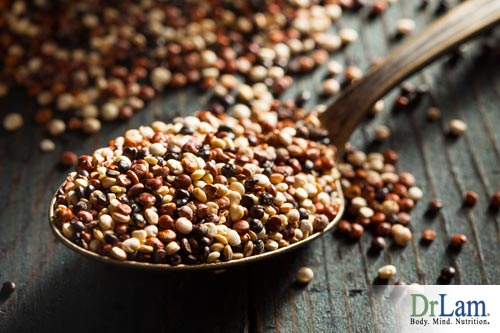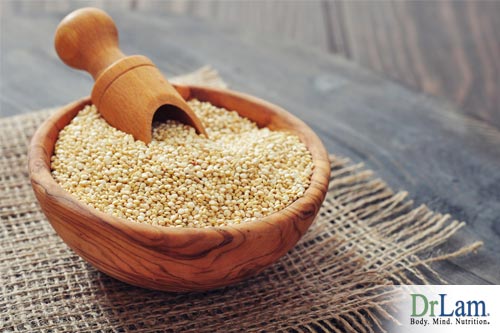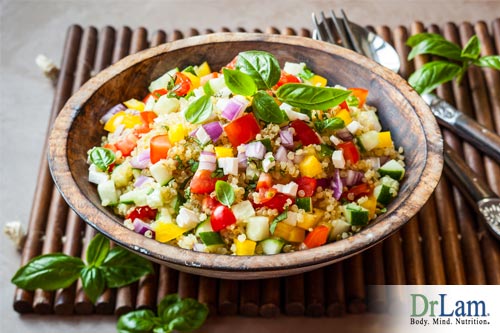 With the proliferation of genetically modified crops, it’s always nice to find a food that hasn’t yet been adulterated. Quinoa is just such a food. Quinoa is classified as a whole grain, though it is not actually a grain. Quinoa is growing in popularity as an easy to prepare and highly nutritious food, but is still unfamiliar to many people. One of the quinoa health benefits is that it is gluten-free, making it a great substitute for wheat and other grains for those individuals who are sensitive or allergic to gluten.
With the proliferation of genetically modified crops, it’s always nice to find a food that hasn’t yet been adulterated. Quinoa is just such a food. Quinoa is classified as a whole grain, though it is not actually a grain. Quinoa is growing in popularity as an easy to prepare and highly nutritious food, but is still unfamiliar to many people. One of the quinoa health benefits is that it is gluten-free, making it a great substitute for wheat and other grains for those individuals who are sensitive or allergic to gluten.
Research is finding quinoa to be packed with phytonutrients that have potent anti-inflammatory properties, including flavonoids such as quercetin and kaempferol. While few human studies have been done, studies show lab animals who were fed quinoa every day had a significantly reduced risk of health conditions related to inflammation.
Quinoa contains more fat, especially healthy monounsaturated fat and omega-3s than traditional whole grains. There is a full gram of fat in only 63 calories worth of quinoa. Because of this, it was thought that quinoa would be more susceptible to oxidation than lower fat grains, but research has shown this not to be the case. Further, it has been found that cooking does not substantially change or compromise the nutritional value of quinoa. While it is unclear why quinoa is so resistant to oxidation and heat, scientists believe the diversity of antioxidants, including a range of compounds in the vitamin E family, are responsible for this protection.
One of the most interesting aspects of quinoa is that, while it is prepared and eaten much like a grain, the nutritional value far surpasses that of just about any other grain commonly eaten. In particular, quinoa contains lysine and isoleucine, the two amino acids missing from other grains that prevent them from providing a complete source of protein.
The nutritional value of quinoa isn’t limited to the seeds, which are the most commonly eaten part of the plant. The leaves are especially high in betacyanins and can be used in place of spinach or arugula in salad and many recipes.
 Quinoa also contains nearly twice the fiber as other grains. Fiber is good for more than treating and preventing constipation, it also helps promote healthy digestion, which can help lower blood pressure, cholesterol, and blood glucose. Fiber helps you fill up fast and feel full longer. Some studies have shown that eating quinoa on a regular basis can reduce your risk of developing type 2 diabetes and help regulate blood sugar levels in those who already have diabetes.
Quinoa also contains nearly twice the fiber as other grains. Fiber is good for more than treating and preventing constipation, it also helps promote healthy digestion, which can help lower blood pressure, cholesterol, and blood glucose. Fiber helps you fill up fast and feel full longer. Some studies have shown that eating quinoa on a regular basis can reduce your risk of developing type 2 diabetes and help regulate blood sugar levels in those who already have diabetes.
Quinoa is high in iron, which is used to form hemoglobin, the primary component in red blood cells and responsible for transporting oxygen to the cells, including brain cells. It is also a rich source of magnesium, which is vital to healthy nerve function and strong bones. Magnesium can reduce the frequency and severity of migraines and reduce the risk of diabetes.
Quinoa and the nutritional benefits of it help support the body while recovering from adrenal fatigue and bringing balance back to the body. Quinoa specifically supports the entire body and most systems in the neuroendocrine metabolic (NEM) response in the body. From iron, which supports our blood for optimal nutrient delivery to the body, to fiber which helps cleanse and detoxify the gut. The NEM response is a holistic approach to changes that occur due to stress in the body. Some foods will aggravate the body, because the immune system is on overdrive due to an imbalance in hormones, which can put too much strain on the immune system. Quinoa, as it is gluten free, will often not trigger an immune response, unlike many other grains such as wheat or barley.
 Ingredients A:
Ingredients A:
Ingredients B:
Ingredients C:
Ingredients D:
Ingredients E:
Method:
Serves 4
